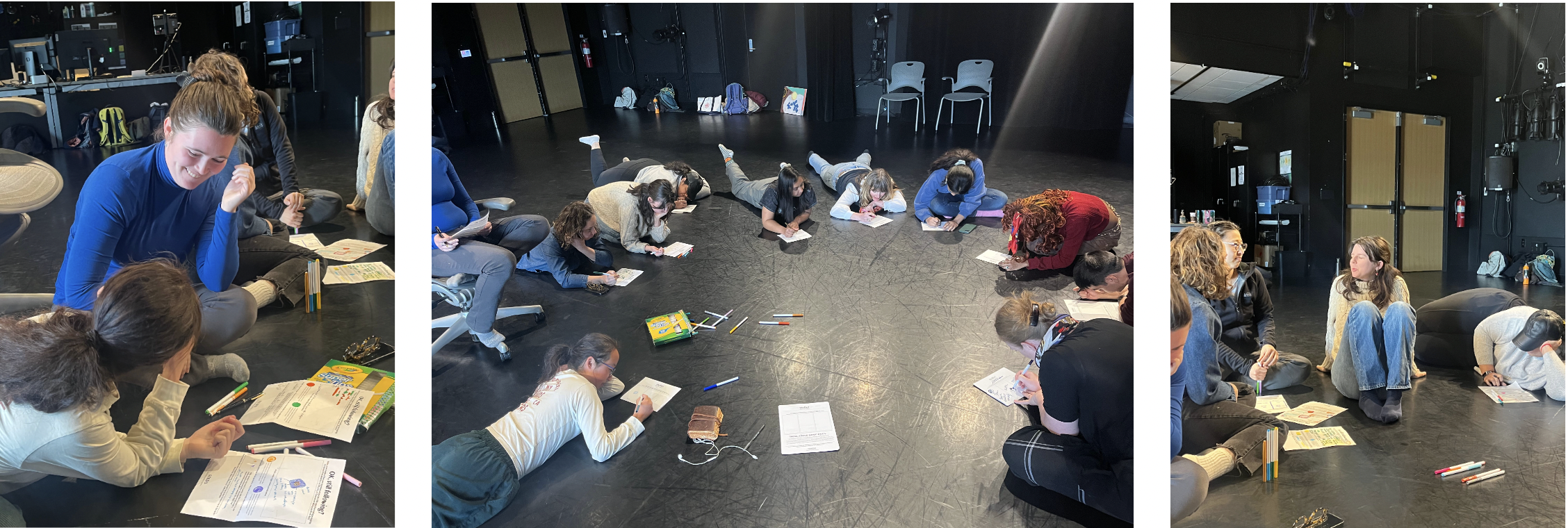SEEDS is a project that stands for Social and Environmental Exercises for Design Beyond Sustainability. I learned from working with Norah in Livable Futures that sustainability too often means sustaining extractive practices. In a time where the term sustainability has become overused, but fails to strengthen our connection to the Earth, I found the opportunity to look at design practices beyond sustainability. These are practices that invite us to remember our part within the intricate systems of the Earth, creating personal and professional action that integrate life of all beings, minerals, plants and unseen forces into our work. I call this way of being (and thinking) Earth-centered, meaning that it shifts our perspective from prioritizing the human species to considering the totality of the Earth when making choices in our lives. Through this intention, SEEDS was born, offering activities that inspire us to take Earth-centered action towards a better collective future for all.
The mission ofLivable Futures is in deep alignment with my overall values and work. Considering future possibilities and acting according to our intentions towards the future is a big part of design practice. We must first envision, so that we can create, and before we envision, we need to contextualize our visions and ideas of the world we live in, and how we perceive this world. Imagining a livable future is part of the work needed to plant these SEEDS and seeds of change and adopt them as parts of our toolkits as creatives.
SEEDS introduces these concepts in a collection of exercises and pedagogies that can be used inside or outside a classroom, with a focus on design education, and with the possibility of application in multidisciplinary spaces. These “seeds” are created with deep reverence and in collaboration with indigenous and ancestral communities and the wisdom they choose to share to strengthen our collective consciousness in reciprocity with the Earth. Learning from the Guarani in Sao Paulo, Brazil, and how they take care of bee medicine, for example, brings inspiration on how we can better design our futures with reverence for the species around us. Their processing of the honey and beeswax centering the bees, and not the byproduct of their living, is an inspiration to build reciprocity when we choose to create with the resources of this Earth. The SEEDS are also based on my personal journey. I am an immigrant and so are most of my direct ancestors, moving from land to land to find belonging and stability for our family. Living now in Turtle Island, I often reflect on ways in which I can honor the earth-centered teachings of my ancestral lineages and find presence to meaningfully show up to the land I am currently in (Ohio). Creating these webs of connection to ourselves and the world around us is what I bring to my practice as a designer and educator. That, alongside the feedback I get from a variety of community driven spaces, like creative studios at OSU and community gatherings, informs the development of SEEDS from a heart centered and community-driven place.
For my work as a Livable Futures fellow this Spring 2024 , I developed two different SEEDS. The first one was created in collaboration with Sophia Hunneycutt, a graduate student in creative writing at OSU. We created a MadLib exercise that invited our peers to envision a better future, in alignment with their beliefs as well as what nourishes them in their lives. The results were wonderful, from very profound reflections to funny and even challenging ones. The guide for our Livable Futures Madlib is included in this post and we’d love for you to use it in your own communities and classrooms and let us know when you do @livablefuturesNow on IG or by commenting on this post. In a MadLib, you never really know what your final text will be, and as a result, sharing the exercise with other peers opened reflections about envisioned and desired futures as well as fear and challenges we might face when creating the futures we would like for our collective.
Mad Lib in class exercise
For the Livable Futures course Sandbox (an opportunity each of us has to share part of our practice with the rest of the community), I developed a SEED called “Object Decomposition.” The intention was to invite reflection on the materiality of everyday objects we use, and how these objects connect or lack connection with the Earth. Through a series of actions and reflections, this SEED guided our group to reflect on the connection between materiality, intention, use and creation. By asking ourselves how these daily objects can further connect us to the Earth, this SEED links us back to design through the concept of recreating our everyday objects, preparing for a future in which Earth-centered ways of being are at the center, and reminding us we are also a part of Nature.
I’m really inspired and energized by the impact of the multimodal ways of facilitating and teaching and excited to continue developing my work in community with colleagues in Design at Ohio State and the Livable Futures community.
Object Decomposition pictures and worksheet.
Object Decomposition worksheet
It has been extremely important and inspiring to engage in these exercises and offer these SEEDS to my community at OSU. This project will keep unfolding, inviting us to connect more deeply with ourselves and our creative practices while fostering an Earth-Centered perspective. By sharing this work with different communities I can further understand the impact of these SEEDS and with time, watch which ones unfold into sprouts, flowers and entire biomes for a more Livable Future.




